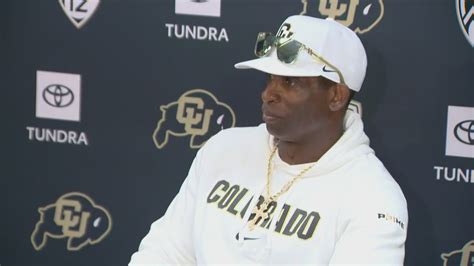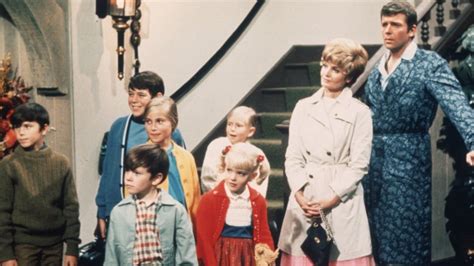
Shedeur Sanders, quarterback for the Colorado Buffaloes and son of head coach Deion Sanders, has been battling a fractured back, revealed Coach Sanders after weeks of speculation surrounding the younger Sanders’ health and performance. The revelation came after a string of subpar performances from Shedeur, prompting widespread discussion and concern among fans and analysts.
Deion Sanders disclosed that Shedeur had been playing with the injury for weeks, explaining the decline in his performance and the difficulties he faced on the field. “He’s been playing with a fractured back,” Sanders stated, offering a definitive explanation for his son’s struggles. This information sheds light on the challenges Shedeur has faced and provides context for his recent performance.
The news arrives amidst a challenging season for the Colorado Buffaloes, who, after a promising start, have struggled to maintain their momentum. Shedeur Sanders, initially a Heisman Trophy contender, has faced increasing pressure as the team’s performance waned.
The revelation of Shedeur’s injury provides a new perspective on the Buffaloes’ season and the quarterback’s individual performance. It also raises questions about the team’s medical protocols and decision-making processes concerning player health.
Details of Shedeur’s Injury and Performance Decline
The disclosure of Shedeur Sanders’ fractured back provides a critical context for understanding his recent performance. Before the injury, Shedeur was considered a frontrunner for the Heisman Trophy, demonstrating exceptional skill and leadership on the field. His early-season performances were marked by accurate passing, smart decision-making, and a commanding presence, leading many to believe he would be a top contender for the prestigious award.
However, as the season progressed, Shedeur’s performance began to decline noticeably. His throws lacked their usual zip, his decision-making seemed slower, and he appeared less mobile in the pocket. These changes sparked intense speculation, with many questioning his readiness and ability to handle the pressures of collegiate football. Some analysts suggested that the increased defensive pressure and the challenges of playing against tougher opponents were taking their toll. Others pointed to possible fatigue or a lack of focus.
Now, with the revelation of his fractured back, it becomes clear that Shedeur was battling a significant physical ailment. The injury likely affected his ability to throw accurately, move comfortably, and withstand the physical demands of each game. According to medical experts, a fractured back can cause significant pain, limited mobility, and reduced core strength, all of which are essential for a quarterback.
“A fractured back can severely limit a quarterback’s ability to perform at their best,” said Dr. Emily Carter, a sports medicine specialist. “The pain and instability can affect throwing mechanics, footwork, and overall mobility, making it difficult to execute plays effectively.”
The fact that Shedeur continued to play despite the injury highlights his toughness and commitment to the team. However, it also raises concerns about the potential long-term effects of playing through such a significant injury. Medical professionals typically recommend rest and rehabilitation for fractured backs to ensure proper healing and prevent further damage.
Deion Sanders addressed the decision to allow Shedeur to play through the injury, emphasizing his son’s desire to compete and the team’s need for his leadership. He acknowledged the risks involved but maintained that they were carefully considered.
“Shedeur is a warrior, and he wanted to be out there for his team,” Deion Sanders said. “We monitored the situation closely and made sure he was able to play without risking further injury. It was a tough decision, but we believed it was the right one.”
However, some critics have questioned the wisdom of allowing Shedeur to play while injured, arguing that it could have exacerbated the injury and potentially jeopardized his long-term health. They also point to the potential impact on the team’s performance, suggesting that a healthy backup quarterback might have been a better option.
The Impact on the Colorado Buffaloes Season
The revelation of Shedeur Sanders’ injury provides a new lens through which to view the Colorado Buffaloes’ season. After a promising 3-0 start, the team has struggled, losing several key games and failing to live up to the high expectations set at the beginning of the season. The initial excitement surrounding the team, fueled by Deion Sanders’ arrival and the influx of talented players, has given way to frustration and disappointment.
Shedeur Sanders was expected to be the driving force behind the Buffaloes’ offense, leading the team with his arm and his decision-making. However, his declining performance coincided with the team’s struggles, leading some to question his ability to lead the team to success.
With the knowledge that Shedeur was playing with a fractured back, it becomes easier to understand the team’s offensive struggles. The injury likely limited his ability to make accurate throws, extend plays with his legs, and effectively lead the offense. Opposing defenses may have also recognized his limitations and adjusted their strategies accordingly, further compounding the challenges.
Deion Sanders acknowledged the impact of Shedeur’s injury on the team’s performance, stating that it was a factor in their recent struggles. He also emphasized that the team needs to find ways to overcome adversity and continue to compete despite the challenges.
“We know we haven’t been playing our best football lately, and Shedeur’s injury has definitely been a factor,” Deion Sanders said. “But we’re not making excuses. We need to find ways to get better and compete at a higher level, regardless of the circumstances.”
The Buffaloes’ coaching staff will now need to reassess their offensive strategy and find ways to maximize the team’s strengths while mitigating the impact of Shedeur’s injury. This may involve relying more on the running game, utilizing shorter passes, and providing Shedeur with additional protection in the pocket.
The Future of Shedeur Sanders and the Buffaloes
The immediate focus for Shedeur Sanders will be on managing his injury and ensuring that it does not worsen. Depending on the severity of the fracture, he may need to rest and rehabilitate his back to allow it to heal properly. Medical professionals will likely conduct further evaluations to determine the best course of treatment and develop a plan for his recovery.
If Shedeur is able to continue playing, he will need to manage the pain and limitations associated with the injury. This may involve wearing a brace, undergoing physical therapy, and adjusting his throwing mechanics to minimize stress on his back. The team’s medical staff will need to closely monitor his condition and ensure that he is not at risk of further injury.
Looking ahead to the future, Shedeur Sanders has the potential to be a star quarterback at the collegiate and professional levels. He possesses the talent, work ethic, and leadership qualities necessary to succeed. However, he will need to stay healthy and continue to develop his skills to reach his full potential.
The Colorado Buffaloes also have a bright future under the leadership of Deion Sanders. Despite the recent struggles, the team has shown flashes of brilliance and has the potential to become a major force in college football. With continued recruiting success and player development, the Buffaloes could be competing for championships in the years to come.
The situation with Shedeur Sanders also brings attention to the broader issue of player health and safety in college football. As athletes become bigger, faster, and stronger, the risk of injury increases. Colleges and universities have a responsibility to provide their athletes with the best possible medical care and to prioritize their health and well-being.
This includes implementing comprehensive injury prevention programs, providing access to top-notch medical facilities, and ensuring that athletes are not pressured to play through injuries. It also requires a culture of transparency and honesty, where athletes feel comfortable reporting injuries and seeking medical attention.
The case of Shedeur Sanders serves as a reminder of the challenges and sacrifices that college athletes face. It also highlights the importance of prioritizing their health and well-being. As fans, coaches, and administrators, we have a responsibility to support these athletes and ensure that they are able to compete safely and successfully.
The circumstances surrounding Shedeur Sanders’ injury raise several important questions about player health, team management, and the pressures of collegiate sports. The coming weeks and months will be crucial for Shedeur’s recovery and for the Buffaloes’ future.
Frequently Asked Questions (FAQ)
- What specific injury did Shedeur Sanders sustain?
Shedeur Sanders sustained a fractured back. The exact nature and location of the fracture were not specified in the source article, but it was indicated that he had been playing with the injury for several weeks.
- How did Deion Sanders reveal the information about Shedeur’s injury?
Deion Sanders revealed the information about Shedeur’s fractured back during a press conference or interview, explaining the reason behind his son’s recent performance decline.
- How has Shedeur Sanders’ performance been affected by the injury?
Shedeur Sanders’ performance has noticeably declined since sustaining the injury. He has struggled with accuracy, mobility, and overall effectiveness on the field, leading to increased scrutiny and concern among fans and analysts.
- Why did Shedeur Sanders continue to play despite having a fractured back?
Shedeur Sanders continued to play due to his desire to compete and his commitment to the team. Deion Sanders mentioned that Shedeur is a “warrior” and wanted to be out there for his teammates. The decision was made after careful consideration of the risks involved.
- What are the potential long-term consequences of playing with a fractured back?
Playing with a fractured back can lead to several potential long-term consequences, including chronic pain, reduced mobility, and the risk of further injury. Proper rest and rehabilitation are crucial for ensuring proper healing and preventing complications.
- What was Shedeur Sanders’ performance like before the injury?
Prior to the injury, Shedeur Sanders was performing at a high level, considered a potential Heisman Trophy candidate. He showed great promise with accurate passing, smart decision-making, and strong leadership on the field, making him a key player for the Colorado Buffaloes.
- How might the revelation of Shedeur’s injury impact the Colorado Buffaloes’ team strategy?
The revelation of Shedeur Sanders’ injury could significantly impact the Colorado Buffaloes’ team strategy. The coaching staff might need to adjust their offensive approach, potentially focusing more on the running game, utilizing shorter passes, and providing additional protection for Shedeur in the pocket to minimize stress on his back. They might also need to consider the possibility of utilizing a backup quarterback if Shedeur’s condition worsens.
- What measures are being taken to ensure Shedeur Sanders’ health and prevent further injury?
To ensure Shedeur Sanders’ health and prevent further injury, the team’s medical staff will likely monitor his condition closely and could involve wearing a brace, undergoing physical therapy, and adjusting his throwing mechanics to minimize stress on his back. The medical team will need to continuously evaluate his condition to prevent any risk of exacerbating the injury.
- How does this situation affect Deion Sanders as both a coach and a father?
As a coach, Deion Sanders faces the challenge of balancing the team’s needs with the health and well-being of his star quarterback. As a father, he must navigate the emotional aspects of seeing his son injured and making difficult decisions about his playing time. This dual role adds complexity to the situation, requiring him to prioritize both his son’s health and the team’s success.
- What is the general medical recommendation for athletes with fractured backs?
The general medical recommendation for athletes with fractured backs typically involves rest and rehabilitation to allow the fracture to heal properly. This may include avoiding strenuous activities, wearing a brace for support, and undergoing physical therapy to regain strength and mobility. The specific treatment plan would depend on the severity and location of the fracture.
- Were there any visible signs or indications of Shedeur Sanders’ injury prior to the official announcement?
Prior to the official announcement, there were visible signs and indications of Shedeur Sanders’ injury through his decreased performance. Observers noted that his throws lacked their usual power, his decision-making seemed slower, and he appeared less mobile in the pocket. These changes led to speculation about his readiness and ability to handle the pressures of collegiate football, but the underlying cause remained unknown until the revelation of his fractured back.
- How has the fanbase reacted to the news of Shedeur Sanders’ injury?
The fanbase has likely reacted with a mix of concern, understanding, and support. While some fans may have been critical of Shedeur’s performance in recent games, the revelation of his injury provides a new context and elicits sympathy. Many fans are likely expressing support for Shedeur’s recovery and hoping for his return to full health. Additionally, some fans may question the decision to allow him to play while injured, raising concerns about player safety.
- What does this news suggest about the team’s transparency regarding player health?
The handling of Shedeur Sanders’ injury raises questions about the team’s transparency regarding player health. While Deion Sanders eventually disclosed the injury, the fact that it was kept secret for several weeks suggests a lack of transparency. This may lead to concerns about the team’s willingness to prioritize player health over competitive advantage. Some critics may argue that the team should have been more forthcoming about the injury to avoid speculation and ensure that Shedeur received proper care.
- How might the injury affect Shedeur Sanders’ future prospects in professional football?
The injury could potentially affect Shedeur Sanders’ future prospects in professional football, depending on the severity of the fracture and the extent of his recovery. While a full recovery could allow him to regain his previous level of performance and maintain his draft stock, any lingering effects of the injury could raise concerns among NFL scouts and general managers. They will likely scrutinize his medical history and assess his long-term durability before making a decision.
- What are some of the ethical considerations for coaches and medical staff when dealing with injured players?
Ethical considerations for coaches and medical staff when dealing with injured players include prioritizing the player’s health and well-being above all else. This involves providing accurate and complete information about the injury, ensuring that the player understands the risks of playing while injured, and allowing the player to make informed decisions about their treatment and return to play. Coaches should avoid pressuring players to play through injuries, and medical staff should advocate for the player’s best interests, even if it conflicts with the team’s goals.
- What other challenges has the Colorado Buffaloes team faced this season?
Besides Shedeur’s injury, the Colorado Buffaloes team has faced several other challenges this season. These challenges include inconsistent defensive performance, difficulties in the running game, and adapting to a highly competitive conference. The team also had to deal with the pressure of high expectations after their initial success, which led to increased scrutiny and criticism as the season progressed.
- How did the media and analysts react to Shedeur Sanders’ initial performance versus his recent performance?
Initially, Shedeur Sanders received significant praise from the media and analysts for his exceptional performance. He was lauded for his arm talent, decision-making, and leadership, and many considered him a Heisman Trophy contender. However, as his performance declined, the media and analysts became more critical, questioning his ability to handle pressure and lead the team effectively. Some speculated about fatigue, lack of focus, or simply facing tougher opponents, but the underlying injury was not known until Deion Sanders’ announcement.
- What kind of support system does Shedeur Sanders have to help him recover?
Shedeur Sanders has a strong support system to help him recover, including his father, Deion Sanders, who is also his coach. He also has access to the Colorado Buffaloes’ medical staff, including doctors, physical therapists, and trainers, who will provide him with the necessary medical care and rehabilitation. Additionally, he likely receives support from his teammates, family, and friends, who can provide emotional encouragement during his recovery process.
- Is there a possibility that Shedeur Sanders will need surgery for his fractured back?
The possibility of Shedeur Sanders needing surgery for his fractured back depends on the severity and type of the fracture, as well as the effectiveness of non-surgical treatments. If the fracture is stable and healing properly with rest and rehabilitation, surgery may not be necessary. However, if the fracture is severe, displaced, or not healing adequately, surgery may be required to stabilize the spine and promote healing.
- What is the significance of Deion Sanders revealing this information at this particular time in the season?
The significance of Deion Sanders revealing this information at this particular time in the season could be multifaceted. It could be an attempt to provide context for the team’s and Shedeur’s recent struggles, deflect criticism, and garner sympathy from fans and media. It could also be a strategic decision to protect Shedeur from further pressure and allow him to focus on his recovery. Furthermore, it might be a way to address concerns about the team’s transparency and demonstrate a commitment to honesty and player well-being. The timing also allows for adjustments to be made for future games.









